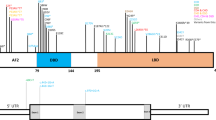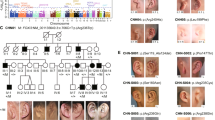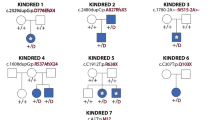Abstract
Neural tube defects (NTD) in humans have been considered to have a multifactorial aetiology, however the participating genes have not been identified. The curly–tail (ct) mutant mouse develops NTD that resemble the human malformations in location, pathology and associated abnormalities. Moreover, there appears to be multifactorial influence on the incidence of NTD in offspring of curly–tail mice. We now describe a linkage analysis that localizes the ct gene to distal chromosome 4 in mice. Further analysis using recombinant inbred strains demonstrates the presence of at least three modifier loci that influence the incidence of NTD. This study provides definitive evidence for multifactorial inheritance in a mouse model of human NTD.
This is a preview of subscription content, access via your institution
Access options
Subscribe to this journal
Receive 12 print issues and online access
$209.00 per year
only $17.42 per issue
Buy this article
- Purchase on Springer Link
- Instant access to full article PDF
Prices may be subject to local taxes which are calculated during checkout
Similar content being viewed by others
References
Laurence, K.M., in Principles and Practice of Medical Genetics 2nd edn (eds A. E. H. Emery & D. L Rimoin) 323–346 (Churchill Livingston, Edinburgh, 1990).
Emery, A.E.H. Methodology in Medical Genetics 2nd edn 58 (Churchill Livingstone, Edinburgh, 1986).
Wald, N., Sneddon, J., Densem, J., Frost, C., Stone, R. & MRC Vitamin Study Research Group. Prevention of neural tube defects: Results of the Medical Research Council vitamin study. Lancet 338, 131–137 (1991).
Czeizel, A.E. & Dudas, I. Prevention of the first occurrence of neural-tube defects by periconceptional vitamin supplementation. New Engl. J. Med. 327, 1832–1835 (1992).
Lammer, E.J., Sever, L.E. & Oakley, G.P. Teratogen update: valproic acid. Teratology 35, 465–473 (1987).
Hobbins, J.C. Diagnosis and management of neural-tube defects today. New Engl. J. Med. 324, 690–691 (1991).
Epstein, D.J., Vekemans, M. & Gros, P. Splotch (Sp2H), a mutation affecting development of the mouse neural tube, shows a deletion within the paired homeodomain of Pax-3. Cell 67, 767–774 (1991).
Thomas, K.R., Musci, T.S., Neumann, P.E. & Capecchi, M.R. Swaying is a mutant allele of the proto-oncogene, Wnt-1. Cell 67, 969–976 (1991).
Hui, C. & Joyner, A.L. A mouse model of Greig cephalopolysyndactyly: The extra-toesJ mutation contains an intragenic deletion of the GIi3 gene. Nature Genet. 3, 241–246 (1993).
Baldwin, C.T., Hoth, C.F., Amos, J.A. da Silva, E.O. & Milunsky, A. An exonic mutation in the HuP2 paired domain gene causes Waardenburg's syndrome. Nature 355, 637–638 (1992).
Tassabehji, M. et al. Waardenburg's syndrome patients have mutations in the human homologue of the Pax-3 paired box gene. Nature 355, 635–636 (1992).
Gruneberg, H. Genetical studies on the skeleton of the mouse: VIII curly-tail. J. Genet. 52, 52–67 (1954).
Embury, S., Seller, M.J., Adinolfi, M. & Polani, P.E. Neural tube defects in curly-tail mice I. Incidence, expression and similarity to the human condition. Proc. R. Soc. Lond. B 206, 85–94 (1979).
Copp, A.J. & Brook, F.A. Does lumbosacral spina bifida arise by failure of neural folding or by defective canalisation? J. med. Genet. 26, 160–166 (1989).
Adinolfi, M., Beck, S.E., Embury, S., Polani, P.E. & Seller, M.J. Levels of alpha-fetoprotein in amniotic fluids of mice (curly-tail) with neural tube defects. J. med. Genet. 13, 511–513 (1976).
Seller, M.J., Embury, S., Polani, P.E. & Adinolfi, M. Neural tube defects in curly-tail mice. II. Effect of maternal administration of vitamin A. Proc. R. Soc. Lond. B 206, 95–107 (1979).
Seller, M.J. & Perkins, K.J. Effect of hydroxyurea on neural tube defects in the curly-tail mouse. J. Craniofac. Genet. Dev. Biol. 3, 11–17 (1983).
Seller, M.J. & Perkins, K.J. Effect of mitomycin C on the neural tube defects of the curly-tail mouse. Teratology 33, 305–309 (1986).
Copp, A.J., Crolla, J.A. & Brook, F.A. Prevention of spinal neural tube defects in the mouse embryo by growth retardation during neurulation. Development 104, 297–303 (1988).
Cockroft, D.L., Brook, F.A. & Copp, A.J. Inositol deficiency increases the susceptibility to neural tube defects of genetically predisposed (curly tail) mouse embryos in vitro. Teratology 45, 223–232 (1992).
Copp, A.J., Seller, M.J. & Polani, P.E. Neural tube development in mutant (curly tail) and normal mouse embryos: the timing of posterior neuropore closure in vivo and in vitro. J. Embryol. exp. Morphol. 69, 151–167 (1982).
Beier, D.R., Dushkin, H. & Sussman, D.J. Mapping genes in the mouse using single-strand conformation polymorphism analysis of recombinant inbred strains and interspecific crosses. Proc. natn. Acad. Sci. U.S.A. 89, 9102–9106 (1992).
Kosambi, D.D. The estimation of map distances from recombination values. Ann. Eugen. 12, 172–175 (1944).
King, T.R., Dove, W.F., Herrmann, B., Moser, A.R. & Shedlovsky, A. Mapping to molecular resolution in the T to H-2 region of the mouse genome with a nested set of meiotic recombinants. Proc. natn. Acad. Sci. U.S.A. 86, 222–226 (1989).
Neumann, P.E. & Collins, R.L. Genetic dissection of susceptibility to audiogenic seizures in crosses of inbred mice. Proc. natn. Acad. Sci. U.S.A. 88, 5408–5412 (1991).
Lathrop, G.M. et al. Strategies for multilocus linkage analysis in humans. Proc. natn. Acad. Sci. U.S.A. 81, 3443–3446 (1984).
Taylor, B.A. . in Genetic Variants and Strains of the Laboratory Mouse 2nd edn (eds M. F. Lyon & A. G. Searle) 773–796 (Oxford University Press, Oxford, (1989).
Taylor, B.A. Genetic analysis of susceptibility to isoniazid-induced seizures in mice. Genetics 83, 373–377 (1976).
Neumann, P.E. Inference in linkage analysis of multifactorial traits using recombinant inbred strains. Behavior Genet. 22, 665–676 (1992).
Finnell, R.H., Moon, S.P., Abbott, L.C., Golden, J.A. & Chernoff, G.F. Strain differences in heat-induced neural tube defects in mice. Teratology 33, 247–252 (1986).
Finnell, R.H., Bennett, G.D., Karras, S.B. & Mohl, V.K. Common hierarchies of susceptibility to the induction of neural tube defects in mouse embryos by valproic acid and its 4-propyl-4-pentenoic acid metabolite. Teratology 38, 313–320 (1988).
Essien, F.B. & Wannberg, S.L. Methionine but not folinic acid or vitamin B-12 alters the frequency of neural tube defects in Axd mutant mice. J. Nutr. 123, 27–34 (1993).
Estibiero, J.P., Brook, F.A. & Copp, A.J. Interaction between splotch (Sp) and curly-tail (ct) mouse mutants in the embryonic development of neural tube defects. Development 119, 113–121 (1993).
Copp, A.J. Relationship between timing of posterior neuropore closure and development of spinal neural tube defects in mutant (curly tail) and normal mouse embryos in culture. J. Embryol. exp. Morphol. 88, 39–54 (1985).
Van Stratten, H.W.M., Hekking, J.W.M., Copp, A.J. & Bernfield, M. Deceleration and acceleration in the rate of posterior neuropore closure during neurulation in the curly tail (ct) mouse embryo. Anat. Embryol. 185, 169–174 (1992).
Copp, A.J. & Bernfield, M. Accumulation of basement membrane-associated hyaluronate is reduced in the posterior neuropore region of mutant (curly tail) mouse embryos developing spinal neural tube defects. Dev. Biol. 130, 583–590 (1988).
Copp, A.J., Brook, F.A. & Roberts, H.J. A cell-type-specific abnormality of cell proliferation in mutant (curly tail) mouse embryos developing spinal neural tube defects. Development 104, 285–295 (1988).
Brook, F.A., Shum, A.S.W., Van Straiten, H.W.M. & Copp, A.J. Curvature of the caudal region is responsible for failure of neural tube closure in the curly tail (ct) mouse embryo. Development 113, 671–678 (1991).
Van Stratten, H.W.M., Hekking, J.W.M., Consten, C. & Copp, A.J. Intrinsic and extrinsic factors in the mechanism of neurulation: effect of curvature of the body axis on closure of the posterior neuropore. Development 117, 1163–1172 (1993).
Eipers, P.G., Barnocski, B.L., Han, J., Carroll, A.J. & Kidd, V.J. Localization of the expressed human p58 protein kinase chromosomal gene to chromosome 1p36 and a highly related sequence to chromosome 15. Genomics 11, 621–629 (1991).
Sartor, O., Moriuchi, R., Sameshima, J.H., Severino, M., Gutkind, J.S. & Robbins, K.C. Diverse biologic properties imparted by the c-fgr proto-oncogene. J. biol. Chem. 267, 3460–3465 (1992).
Carey, D.J. et al. Molecular cloning and characterization of N-syndecan, a novel transmembrane heparan sulfate proteogiycan. J. Cell Biol. 117, 191–201 (1992).
Chernousov, M.A. & Carey, D.J. N-syndecan (syndecan-3) from neonatal rat brain binds basic fibroblast growth factor. J. biol. Chem. 268, 16810–16814 (1993).
Noonan, D.M. & Hassel, J.R. Proteoglycans of the basement membrane. In Molecular and Cellular Aspects of Basement Membranes (eds D. H. Rohrbach & R. Timpl) 189–210 (Academic Press, New York, 1993).
Bernfield, M., Banerjee, S.D., Koda, J.E. & Rapraeger, A.C. Remodeling of the basement membrane as a mechanism of morphogenetic tissue interaction. In The Role of ExtraCellular Matrix in Development: The 42nd Symposium of the Society for Developmental Biology (ed. Treistad, R.) 545–572 (Alan R. Liss, Inc., New York, 1984).
Jostes, B., Walther, C. & Gruss, P. The murine paired box gene, Pax7, is expressed specifically during development of the nervous and muscular system. Mech. Devel. 33, 27–38 (1991).
Frankel, W.N., Stoye, J.P., Taylor, B.A. & Coffin, J.M. A linkage map of endogenous murine leukemia proviruses. Genetics 124, 221–236 (1990).
Messer, A., Plummer, J., Maskin, P., Coffin, J.M. & Frankel, W.N. Mapping of the motor neuron degeneration (Mnd) gene, a mouse model of amyotrophic lateral sclerosis (ALS). Genomics 13, 797–802 (1992).
Cornall, R.J., Aitman, T.J., Heame, C.M. & Todd, J.A. The generation of a library of PCR-analyzed microsatellite variants for genetic mapping of the mouse genome. Genomics 10, 874–881 (1991).
Dietrich, W. et al. A genetic map of the mouse suitable for typing intraspecific crosses. Genetics 131, 423–447 (1992).
Hearne, C.M. et al. Additional microsatellite markers for mouse genome mapping. Mamm. Genome 1, 273–282 (1991).
Author information
Authors and Affiliations
Rights and permissions
About this article
Cite this article
Neumann, P., Frankel, W., Letts, V. et al. Multifactorial inheritance of neural tube defects: localization of the major gene and recognition of modifiers in ct mutant mice. Nat Genet 6, 357–362 (1994). https://doi.org/10.1038/ng0494-357
Received:
Accepted:
Issue Date:
DOI: https://doi.org/10.1038/ng0494-357
This article is cited by
-
Inositol- and folate-resistant neural tube defects in mice lacking the epithelial-specific factor Grhl-3
Nature Medicine (2003)
-
Modifier genes in mice and humans
Nature Reviews Genetics (2001)
-
Control of neurulation by the nucleosome assembly protein-1–like 2
Nature Genetics (2000)
-
Inositol prevents folate-resistant neural tube defects in the mouse
Nature Medicine (1997)
-
Mapping of a major genetic modifier of embryonic lethality in TGFβ1 knockout mice
Nature Genetics (1997)



